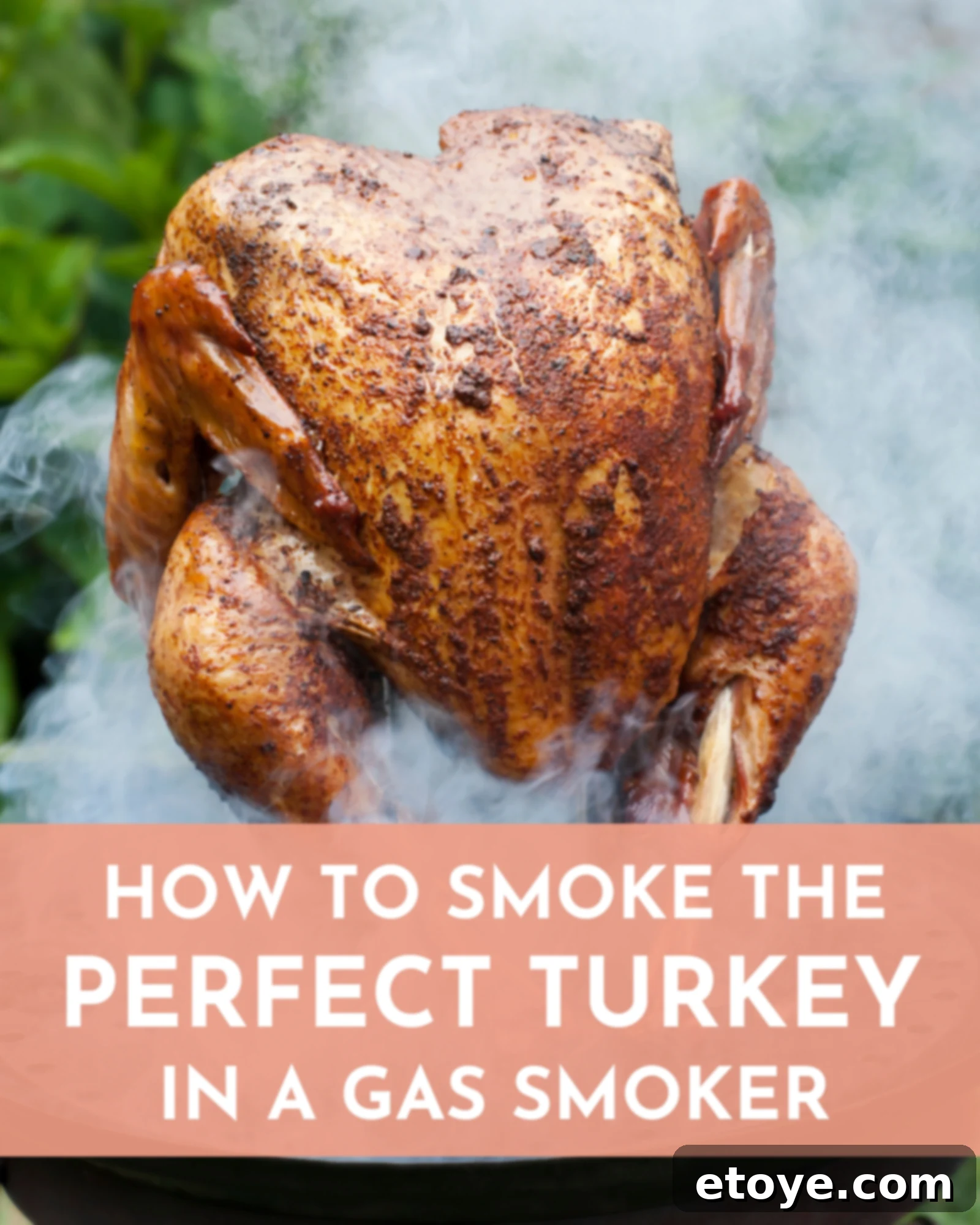Mastering the Art of Smoked Turkey for an Unforgettable Thanksgiving Feast
Thanksgiving is a cherished holiday, synonymous with family, gratitude, and, most importantly, a magnificent feast centered around a perfectly cooked turkey. While the traditional roasted turkey holds a special place in our hearts, those with access to a smoker have an opportunity to elevate their holiday meal to an entirely new level. Smoking your Thanksgiving turkey infuses it with a deep, complex flavor and creates an unparalleled tender juiciness that will make you wonder why you ever settled for the oven.
Beyond the incredible taste and texture, smoking a turkey, especially with a modern gas smoker, simplifies your holiday preparations. Gone are the days of constantly basting and fretting over oven space. With a gas smoker, you can set the temperature, add your wood chips, and let the magic happen mostly hands-off. This frees you up to focus on other dishes, entertain guests, or simply relax and enjoy the festive atmosphere. Prepare to impress your family and friends with a show-stopping smoked turkey that will be the talk of the table.

Why Choose a Smoked Turkey This Thanksgiving?
The allure of a smoked turkey goes far beyond novelty; it offers several compelling advantages over its oven-roasted counterpart. First and foremost is the unparalleled flavor profile. Smoking imparts a rich, earthy, and subtly sweet or savory taste, depending on your choice of wood, that permeates every fiber of the meat. This depth of flavor is simply unattainable through conventional roasting methods.
Moreover, the slow, low-temperature cooking process of smoking is ideal for turkey. It gently breaks down connective tissues, resulting in incredibly tender and succulent meat that practically melts in your mouth. The skin, often a challenge with roasting, achieves a beautiful crispness and a gorgeous mahogany hue. Another significant benefit for the busy Thanksgiving host is the liberation of your oven. With the turkey happily smoking away outside, your oven remains free for all those essential side dishes, casseroles, and delectable pies, streamlining your kitchen operations and reducing stress.

Selecting the Perfect Turkey for Smoking
The journey to an exceptional smoked turkey begins long before it hits the smoker—it starts with selecting the right bird. Your choices here will significantly influence the final texture, flavor, and cooking time.
Fresh vs. Frozen Turkey: Making the Right Choice
One of your first decisions will be whether to opt for a fresh or frozen turkey. While both can yield delicious results, understanding their differences is key to successful preparation.
- Fresh Turkey: Generally, fresh turkeys offer superior texture and moisture retention. They haven’t undergone the freezing and thawing process, which can sometimes impact cell structure, making them more receptive to brining and absorbing smoky flavors more effectively. The convenience of not having to thaw a massive bird on Thanksgiving week is also a huge plus. If you have access to a reliable source, a fresh turkey is often the preferred choice for discerning chefs.
- Frozen Turkey: Frozen turkeys are widely available, often more affordable, and can be purchased well in advance, reducing last-minute stress. If you choose a frozen bird, proper thawing is paramount. Plan for ample time – approximately 24 hours in the refrigerator for every 4-5 pounds of turkey. For example, a 12-pound turkey will require about 3 days to thaw completely and safely. Always thaw your turkey in the refrigerator, never at room temperature, to prevent bacterial growth. For a quicker thaw, submerge the turkey (still in its original packaging) in a sink filled with cold water, changing the water every 30 minutes. While faster, this method requires more attention and isn’t as hands-off as refrigerator thawing.
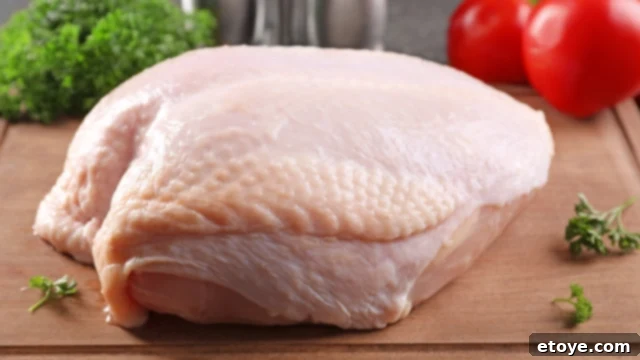
Ideal Turkey Size and Weight for Smoking
When it comes to smoking, size matters. The “low and slow” nature of smoking means that larger birds take significantly longer to cook, which can pose challenges. A general rule of thumb for optimal smoking results is to aim for a turkey between 10 and 14 pounds.
Why this size? Turkeys over 15 pounds risk spending too much time in the “danger zone” (temperatures between 40°F and 140°F), where harmful bacteria multiply rapidly. Smaller birds cook more evenly and efficiently, reducing the risk of unsafe temperatures and ensuring a consistent internal temperature throughout. This also helps prevent the breast meat from drying out while you wait for the thicker parts, like the thighs, to reach their target temperature. If you’re feeding a large crowd, consider smoking two smaller turkeys rather than one colossal one. This approach not only enhances food safety but also often yields better overall texture and flavor.
Exploring Organic, Free-Range, and Heritage Turkey Options
Beyond fresh or frozen, the type of turkey you select can significantly impact its flavor, texture, and even your peace of mind regarding ethical sourcing.
- Organic Turkeys: These birds are raised on organic feed, without antibiotics, hormones, or synthetic pesticides. Choosing an organic turkey often means a cleaner, more natural flavor profile, as well as being a healthier option. They tend to be a bit pricier, reflecting the higher standards of their upbringing.
- Free-Range Turkeys: For those prioritizing animal welfare, free-range turkeys are a wonderful choice. These birds are given access to outdoor spaces, allowing them to roam, forage, and exercise. This active lifestyle typically results in leaner, firmer, and more flavorful meat with a noticeable texture difference compared to conventionally raised birds. The exercise contributes to more developed muscles, enhancing the juicy, smoky experience.
- Heritage Turkeys: A favorite among food connoisseurs and those seeking a taste of tradition, heritage turkeys are descendants of older, traditional turkey breeds. They are often smaller than modern broad-breasted varieties, but they are packed with rich, intense flavor. Heritage turkeys also boast a higher ratio of dark meat to white meat, appealing to those who prefer the more robust taste of thigh and drumstick meat. Their natural foraging habits and slower growth rates contribute to their distinct flavor and texture, and they often cook faster than their commercial counterparts, making them excellent candidates for smoking.
For the best selection of quality turkeys, consider visiting local farmers’ markets, specialty butchers, or reputable online purveyors. Always remember to order well in advance, especially for popular options like heritage or fresh turkeys, to ensure availability for your Thanksgiving feast.

Preparing Your Gas Smoker for Success
A gas smoker is a fantastic tool for achieving consistent, delicious results with minimal fuss. Proper setup is essential to ensure a smooth smoking process from start to finish.
Choosing the Right Wood Chips for Flavor Infusion
The type of wood you use is arguably the most critical element in defining the smoky flavor of your turkey. Different woods impart distinct characteristics, allowing you to customize your bird’s taste profile:
- Hickory: A classic choice for BBQ, hickory provides a strong, bacon-like smoky flavor that’s robust and assertive. It’s excellent for those who love a bold, traditional smoke profile.
- Apple Wood: Offering a sweeter, milder, and fruity smoke, apple wood complements poultry beautifully without overpowering its natural flavors. It’s a great choice for a subtle, aromatic smoke.
- Cherry Wood: Similar to apple, cherry wood delivers a slightly sweet and fruity smoke, often imparting a gorgeous reddish-brown hue to the turkey’s skin. It’s a versatile wood that pairs well with most meats.
- Pecan Wood: A slightly milder and nuttier flavor than hickory, pecan provides a rich, sweet, and complex smoke that’s fantastic with turkey.
- Oak: A medium-strength wood, oak offers a classic smoky flavor that’s less intense than hickory but more robust than fruit woods. It’s a reliable all-around choice.
For gas smokers, you’ll typically place wood chips in a smoker box or a foil packet directly over the heat source (or in a dedicated chip tray). Soak wood chips for about 30 minutes before use to ensure a longer, more consistent smoke rather than a quick flare-up. You’ll only need to add new chips every hour or two, depending on your smoker model.

Essential Equipment: Propane and Thermometers
Before you even think about lighting your smoker, double-check your propane tank. There’s nothing more frustrating than running out of gas halfway through a long smoke. Always have a full spare tank on hand, especially for a holiday meal that requires several hours of cooking.
Equally crucial is an accurate thermometer. Since precise temperature control is the cornerstone of successful smoking, a reliable meat thermometer is indispensable. You’ll need at least two: one for monitoring the ambient temperature inside the smoker and one for checking the turkey’s internal temperature. An instant-read thermometer is perfect for quick spot checks, while a remote probe thermometer (with a wired probe that stays in the turkey and a display unit outside the smoker) allows you to monitor the internal temperature without opening the smoker lid, which can cause temperature fluctuations and extend cooking time. Avoid relying solely on pop-up timers, as they are notoriously inaccurate.

Mastering Turkey Preparation for the Smoker
Proper preparation is the secret ingredient for a truly exceptional smoked turkey. These steps ensure your bird is flavorful, moist, and cooks perfectly.
Determining the Right Amount of Turkey
A common question every Thanksgiving: How much turkey do I need? A good rule of thumb is to plan for 1 to 1.5 pounds of turkey per person. Since a whole turkey includes bones and other non-edible parts, aiming for the higher end – around 1.5 pounds per person – is a safe bet. This ensures everyone gets a satisfying serving and leaves you with plenty of delicious leftovers for sandwiches, soups, and creative post-Thanksgiving meals.
Thawing and Removing Innards Safely
As discussed, ensure your turkey is completely thawed before proceeding with any preparation steps. This means planning ahead and allocating approximately 24 hours of refrigerator thawing time for every 4-5 pounds of turkey. Once thawed, carefully remove the giblets (heart, liver, gizzard) and the neck from both the main cavity and the neck cavity. These can be saved for gravy or stuffing if desired, or simply discarded.
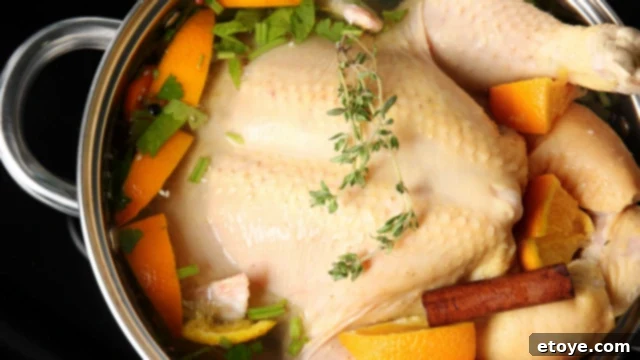
The Art of Brining for Ultimate Juiciness
Brining is arguably the most crucial step for achieving a moist, flavorful smoked turkey. It involves soaking the turkey in a saltwater solution, often enhanced with other aromatics, sugars, and herbs. The salt in the brine works through osmosis to help the turkey meat absorb and retain moisture, preventing it from drying out during the long smoking process.
- Wet Brine: A classic wet brine involves submerging the turkey in a solution of water, salt, and your choice of flavorings like brown sugar, garlic, bay leaves, peppercorns, rosemary, and thyme. A good ratio is typically 1 cup of kosher salt per gallon of water. For a 12-pound turkey, you’ll likely need 2-3 gallons of brine. Brine your turkey for at least 1 hour per pound, with overnight (10-12 hours) being ideal for maximum flavor and moisture. Always keep the turkey and brine refrigerated during this process.
- Dry Brine: A simpler alternative, dry brining involves rubbing the turkey’s exterior liberally with kosher salt (and sometimes a blend of sugar and spices). The salt draws out moisture from the turkey, which then mixes with the salt to create a natural brine that is reabsorbed. This method also helps crisp up the skin by slightly dehydrating it in the fridge. Apply the dry brine and let the turkey sit uncovered in the refrigerator for 24 to 72 hours.
Important Note: If you’ve purchased a “pre-brined” or “self-basting” turkey (which often contains injected saltwater solutions), skip the brining step. Double-brining can result in an overly salty bird. Simply rinse the exterior of a pre-brined bird with cold water before seasoning.
After brining (wet or dry), always rinse the turkey thoroughly under cold running water to remove excess salt. Then, pat it completely dry with paper towels, or even better, let it air dry in the refrigerator for a few hours. A dry surface promotes crispy skin.
Seasoning Your Smoked Turkey to Perfection
Once brined and dried, it’s time to season your turkey. The possibilities are endless, but sometimes the simplest approach yields the best results. A classic combination of kosher salt (if not dry brined), freshly ground black pepper, and fresh or dried herbs like rosemary, thyme, and sage works wonders, complementing the smoky flavor without overpowering it.
For those feeling more adventurous, consider a bold Cajun-style dry rub for a spicy kick, or a sweet rub featuring brown sugar, paprika, and other warm spices to encourage beautiful caramelization of the skin. Be aware that sugar-based rubs will significantly darken the skin during smoking; don’t mistake this rich, caramelized hue for being burnt.
To Stuff or Not to Stuff a Smoked Turkey?
When it comes to smoking a turkey, the general consensus is to avoid stuffing the cavity. Stuffing acts as an insulator, significantly extending the cooking time of the turkey and making it difficult to ensure both the turkey and the stuffing reach a safe internal temperature simultaneously. This often leads to overcooked, dry breast meat while you wait for the stuffing to finish.
Instead, lightly fill the cavity with aromatic elements like apple wedges, onion quarters, celery stalks, fresh herbs (rosemary, thyme, sage), or citrus halves (lemons, oranges). These aromatics will infuse the turkey with subtle flavors and moisture from the inside without hindering even cooking. Just be sure to remove and discard these aromatics once the turkey is cooked.

The Importance of Trussing and Tucking
Trussing is a simple yet effective technique that promotes even cooking and a more attractive presentation. Here’s how to do it:
- Position: Place the turkey breast-side up on your clean prep surface, with the legs pointing towards you.
- Tie: Using butcher’s twine, wrap it around the turkey’s legs, pulling them together tightly. Tie them securely so they stay close to the body. You can also run the twine under the wings and over the breast to further secure the shape.
- Tuck: Fold the wing tips back and tuck them underneath the turkey’s shoulders. This prevents them from burning or becoming overly dry during the long smoke.
Why Truss and Tuck? Trussing ensures that the turkey cooks more uniformly by keeping the legs and wings tight against the body. This prevents the extremities from cooking faster than the breast and drying out. It also creates a more compact shape, which can aid in even heat distribution.
After all prepping, give your turkey one final pat-down with paper towels to remove any residual moisture from the skin. A dry skin is a crispy skin!
The Secret to Irresistibly Crispy Skin: A Touch of Fat
Achieving that coveted crispy, golden-brown skin on a smoked turkey is easier than you might think. Just before placing your turkey in the smoker, lightly coat the entire exterior with olive oil or melted butter. This thin layer of fat will help the skin render and crisp up beautifully under the low, consistent heat of the smoker, providing that delightful crunch with every bite.
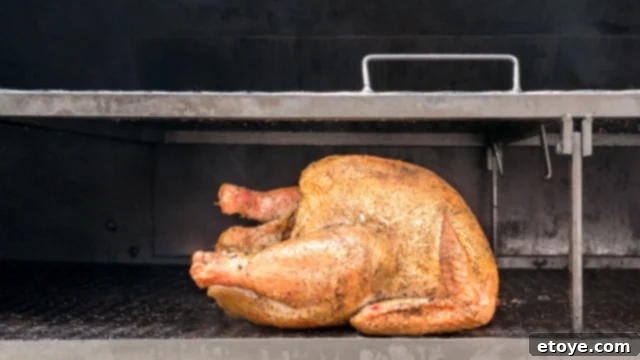
The Smoking Process: From Smoker to Table
With your turkey prepped and your smoker ready, it’s time to bring everything together for a truly memorable meal.
Preheating Your Gas Smoker to Perfection
Consistency is key when smoking. You want to expose your turkey to stable, indirect heat throughout the cooking process. For turkey, the ideal temperature for a gas smoker is a steady 225°F (107°C). To preheat, simply set your smoker to this temperature and allow it to come up to heat, which can take 15-30 minutes. Ensure the internal ambient temperature of the smoker is stable before placing the turkey inside. This ensures the turkey begins cooking immediately and consistently.
Placing the Turkey for Optimal Cooking
Once your smoker is preheated, carefully place the turkey directly on the grates, breast-side up, over the side of the smoker with indirect heat (or in the center if your smoker distributes heat evenly for indirect cooking). There’s no need for a roasting pan; direct contact with the grates allows for better airflow and smoke penetration around the entire bird. Keeping the breast side up helps protect the delicate breast meat from drying out, allowing any melting butter or oil to baste it naturally as it cooks, enhancing both flavor and moisture.
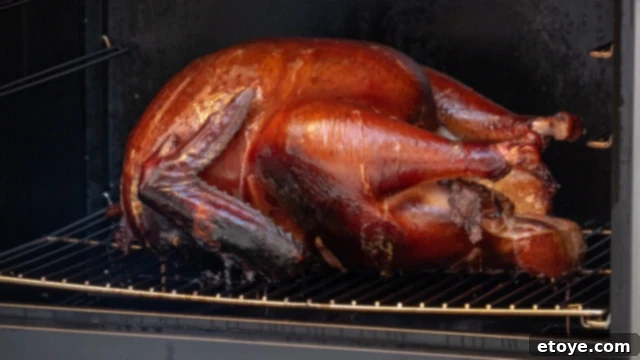
Smoking the Turkey to Culinary Excellence
Now, the magic begins! Close the smoker lid and let your gas smoker do its work. As a general guideline, plan for approximately 30 minutes of smoking time per pound of turkey at 225°F. So, a 12-pound turkey will typically require around 6 hours of smoking. However, this is just an estimate; the true indicator of doneness is the internal temperature.
The turkey is perfectly cooked when it reaches an internal temperature of 165°F (74°C) in the thickest part of the breast, without touching the bone. Use your reliable instant-read or remote probe thermometer to check the temperature. For larger or bone-in birds, it’s wise to check in a few different spots to confirm even cooking. Resist the urge to frequently open the smoker lid, as this releases heat and smoke, prolonging the cooking time and affecting the final product.
The Essential Rest Period
Once your turkey reaches 165°F, carefully remove it from the smoker and place it on a clean cutting board. Tent it loosely with aluminum foil and let it rest for at least 15-30 minutes before carving. This resting period is critical; it allows the muscle fibers to relax and the internal juices to redistribute evenly throughout the meat, ensuring every slice is incredibly moist and flavorful. Skipping this step can result in dry meat, as the juices will simply run out onto the cutting board.
If your turkey finishes cooking ahead of schedule, you can keep it warm during the rest by wrapping it tightly in aluminum foil, then wrapping that package in thick towels, and placing it in a cooler (without ice). This method can keep the turkey warm for 1-2 hours without overcooking. Be aware that this insulation might soften the crispy skin. If you want to re-crisp it just before serving, place the turkey in a preheated oven under the broiler for a couple of minutes, keeping a close eye on it to prevent burning.
Carve and Savor Your Masterpiece!
Finally, the moment you’ve been waiting for! Carve your perfectly smoked turkey, knowing that your efforts have resulted in a truly exceptional main course. Whether you’re a fan of light meat or dark meat (or both!), you’ll be delighted by the rich, smoky flavor, the incredible tenderness, and the satisfying juiciness that only a properly smoked turkey can deliver. And the best part? Much of this hands-off process allowed you to enjoy your holiday without being tied to the kitchen. Your guests will be raving about this unforgettable Thanksgiving centerpiece!
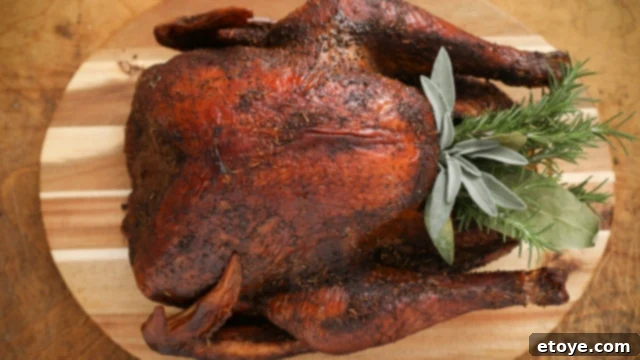
Happy Thanksgiving from Our Kitchen to Yours!
We sincerely hope this comprehensive guide inspires you to try smoking your turkey in a gas smoker this Thanksgiving. The depth of flavor and tender juiciness it delivers are truly unparalleled, promising a memorable meal for all your loved ones. If you enjoyed discovering new ways to prepare your holiday bird, you might also be interested in our guide on How To Deep Fry A Turkey With No Oil!
What delightful side dishes will you be serving alongside your magnificent smoked turkey? Will it be the classic mashed potatoes, a savory stuffing, and tangy cranberry sauce? Or do you venture beyond tradition with unique culinary creations? We’d love to hear your favorite tips, tricks, and cherished traditions for preparing your Thanksgiving turkey and celebrating the season. Please share your thoughts and comments below!
As always, from our Steamy family to yours, we extend our warmest wishes for a safe, joyful, and delicious holiday season. May your turkey be wonderfully flavorful and your bellies be happily full!
You Might Also Enjoy…
- 5 of the Best BBQ Recipes to Make in Your Smoker
- Creative Meal Ideas For Turkey Day Leftovers
- Deep Fried Turkey Without Oil: A Healthier Alternative
